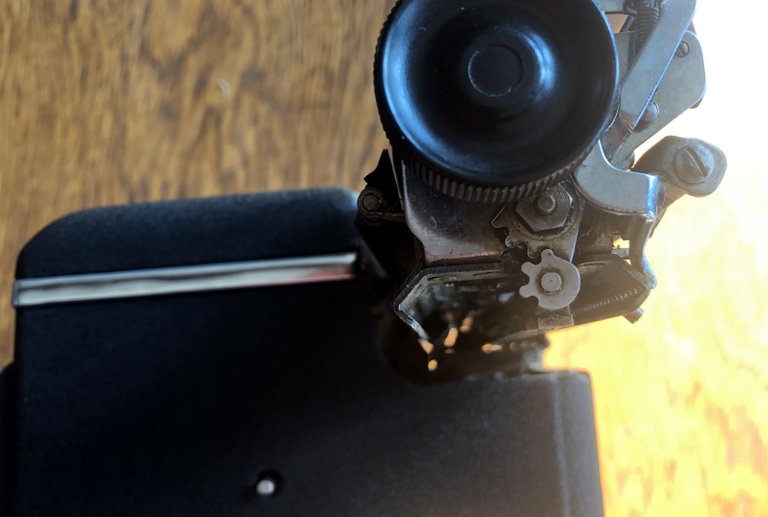When I'm not busy working, or running in circles around my neighborhood, or railing against god, my favored method of procrastination is to potter about the house on some ridiculous project or other.
There's always something to do that's more satisfying than what you should be doing, isn't there?
Yesterday I came across this typewriter.
Regular readers may recall that I'd carted a significant collection of manual typewriters up to Cambridge several months ago. Once much loved, these machines (much like my books) had come to represent weight, hoarding, and clutter.
In any case, it made more sense to have one machine I might actually use sometimes, than a dozen sitting on a closet shelf, unenjoyed. To that end, I traded them all in at Cambridge Typewriter for one rather amazing Olympia. Professionally restored, it provided the surreal experience of typing on a 50 year old keyboard that felt like it was still sparkling on the showroom floor.
This is perfect, I thought. Now, I'll never need another. I used it to write that post, then put it away and forgot about typewriters for the next six months.
Well, the other day I went out to the boathouse for something and had my eye caught by a distinctive, mildewed black box with a handle on top. That old acquisitive, dopamine-driven bit of my hindbrain dinged "typewriter," which is kind of silly because I already own everything in that damn building. I'm not acquiring anything, here.
But somehow this Royal Companion Portable escaped the great typewriter purge of 2021. I must have moved it out here during one of our AirBnB adventures, when we'd vacated the house in the name of rental income, and I'd brought one typewriter with me in case I felt the need to do some high impact writing. It never made the move back at the end of the season.
So I thought, That's alright. What harm can keeping two typewriters cause? After all, the whole reason this one was out here was because it had been a favorite.
Just look at how cute and compact and stately it is! The round glass keys! The old fashioned carriage-shift mechanism (which raises the carriage rather than lowering the basket to produce the capital letters) abandoned by the mid 1940s.
Unfortunately, it was broken.
Here's the thing: if it worked, I could have tapped at it for a minute and then put it away. But it didn't. So I needed to fix it. It was broken, and I can't have another broken treasure in my house.
Not physically broken. Just... didn't-work-broken. A couple years in a damp unheated building had made it musty, and the carriage no longer moved.
I didn't care too much about the mildew, beyond a quick wipe down. I knew that, if I could get it working again, it would pretty much clean itself with some use. It's amazing how much better these machines look and feel when you just start using them again.
The lazy carriage, on the other hand, took some head scratching. And exploration. Eventually I discovered the severed ends of the old draw-band. It had gotten brittle and let go sometime in the intervening years; I imagined the metallic whizz of the spring giving up its tension out in the darkness of neglect, and startling some mouse.
Fortunately I'd handled this sort of problem before.
See this wheel? There's a spring inside. And there's a little notch to attach a string, there.
At the other end, we find a hook for the opposite end of the string. It should be a fairly simple operation to attach these two points. The trouble comes with (1) finding the appropriate string, (2) getting it through the narrow channel under the carriage without fetching up on all the mechanical bits and bobs crowding for space in there, and (3) winding that spring up to the proper tension.
You might think that, so close to the ocean, we'd have a decent selection of fishing line that would be perfect for this task. You'd be wrong. I've already got more hobbies than time, and fishing just isn't something I'm going to invest money in being bad at.
In the past, I've used a shoelace as a typewriter drawband. Once I used the trimmer line from a weed-wacker. Those must have been bigger machines. This springwheel is too narrow for a cable of that circumference.
In the end I went with some heavy black thread. Not because it's the right material, but because it's in the house. (What was I supposed to do, leave the house on my day off? Let's not be absurd.) I'm not convinced it won't wear through and snap in short order, but I figured if I couldn't break it by pulling on it, it would do for now. And if it did break again, well, then I'd have another hour to spend fixing a small problem and distracting myself from the bigger ones. Win-win!
Getting the string down that channel turned out to be quite the challenge, though. In the end, I turned the typewriter on its side, attached a needle to the string, and dangled it through, working the carriage back and forth to encourage it when it got stuck. I wound up having to do this twice, because the first time it worked free of the spring and came flying back through.
So yeah, that spring can be a little bitch. It might be the only way you can injure yourself, working on these gentle old machines. The trick is to torque it up until it provides an appropriate pulling force (which I scientifically measured as feels about right) and then keep it from whizzing away and slicing your finger as you work out how to tie a loop at the end of a piece of string.
Tying a knot is a task I feel, at the age of 45, I should have mastered long ago.
Wedging a large screwdriver next to the wheel seemed to hold it in place, so I could tackle the problem of the string with both hands. I made due with some combination of granny knots and swearing. Once the knot was in place, it was just a matter of removing the screwdriver and letting the spring take up the slack.
Then I made sure the carriage moved fast enough that the letters didn't bunch together, but not with so much force that it bounces back with each keypress. Either way would lead to irregularly spaced type, and nobody wants that.
I'm sure Tom at Cambridge Typewriter would have performed this operation in a fraction of the time.
No doubt he'd cringe at my ministrations. And who knows, I might wind up just selling this typewriter to him eventually.
But part of the joy of these machines is that a knucklehead like me can peer into the guts and more-or-less work out how it functions - and even get it working again with a little time and attention.
So I'll hang on to it for now, and maybe even use it once or twice.


Unless otherwise stated, photography is the work of the author. Feel free to copy, remix and share photographs from this post according to the terms of a Creative Commons Attribution Sharealike 4.0 International license.
Camera divider and signature illustration by @atopy.






You do know that's how all hoarders start, right? :P
Man, you're resourceful. A shoelace for a typewriter band - I don't think I would've thought of that in a million years. You're definitely my typewriter guy once I do get my hands on. There's something just entrancing about that last shot of typed pages.
Reminds me of the old type writer that we had in my old office. I used it before to put initials on the letters that I make.
Your content has been voted as a part of Encouragement program. Keep up the good work!
Use Ecency daily to boost your growth on platform!
Support Ecency
Vote for new Proposal
Delegate HP and earn more